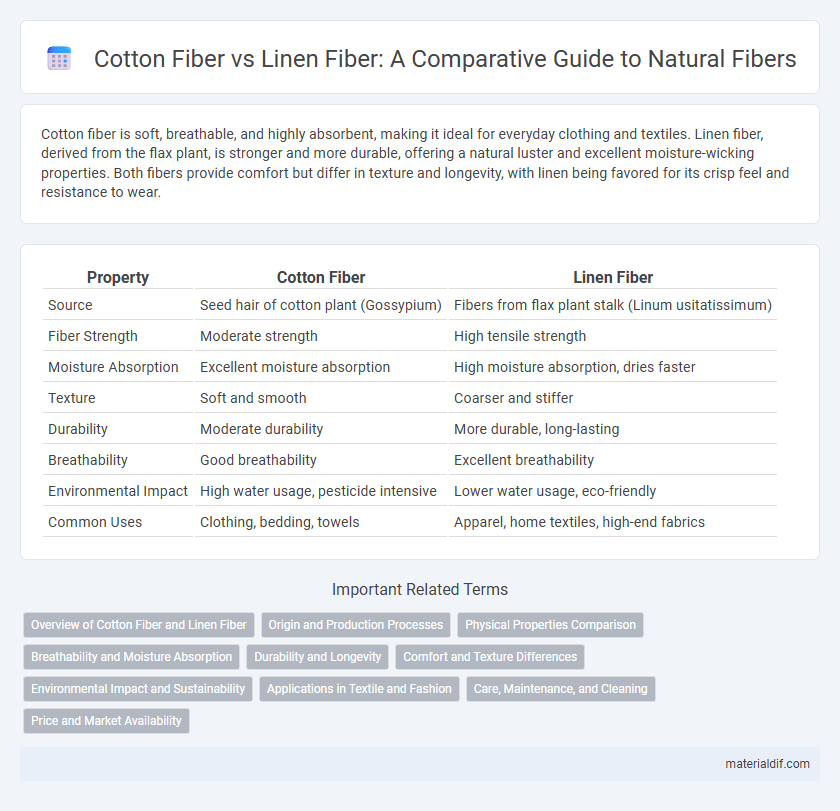Cotton fiber is soft, breathable, and highly absorbent, making it ideal for everyday clothing and textiles. Linen fiber, derived from the flax plant, is stronger and more durable, offering a natural luster and excellent moisture-wicking properties. Both fibers provide comfort but differ in texture and longevity, with linen being favored for its crisp feel and resistance to wear.
Table of Comparison
| Property | Cotton Fiber | Linen Fiber |
|---|---|---|
| Source | Seed hair of cotton plant (Gossypium) | Fibers from flax plant stalk (Linum usitatissimum) |
| Fiber Strength | Moderate strength | High tensile strength |
| Moisture Absorption | Excellent moisture absorption | High moisture absorption, dries faster |
| Texture | Soft and smooth | Coarser and stiffer |
| Durability | Moderate durability | More durable, long-lasting |
| Breathability | Good breathability | Excellent breathability |
| Environmental Impact | High water usage, pesticide intensive | Lower water usage, eco-friendly |
| Common Uses | Clothing, bedding, towels | Apparel, home textiles, high-end fabrics |
Overview of Cotton Fiber and Linen Fiber
Cotton fiber, derived from the seed hairs of the cotton plant, is known for its softness, breathability, and high moisture absorbency, making it ideal for everyday textiles and clothing. Linen fiber, obtained from the flax plant's stalks, features exceptional strength, durability, and natural luster, often used in lightweight fabrics for warm climates. Both fibers offer distinct characteristics in texture and performance, with cotton providing comfort and linen offering a crisp, durable finish.
Origin and Production Processes
Cotton fiber originates from the seed hairs of cotton plants primarily grown in regions such as the United States, India, and China, harvested through mechanical picking, followed by ginning to separate fibers from seeds. Linen fiber is derived from the flax plant's stem, predominantly cultivated in Europe and Canada, involving retting, scutching, and hackling processes to extract and cleanse the long, strong fibers. The production process of cotton emphasizes fiber softening and short staple use, whereas linen production centers on extracting longer, more durable fibers for high-strength textile applications.
Physical Properties Comparison
Cotton fiber is soft, breathable, and has high moisture absorbency, making it comfortable for everyday wear, while linen fiber is stronger, with greater tensile strength and durability. Linen fiber exhibits excellent moisture-wicking properties and dries faster than cotton, contributing to its natural resistance to mildew and bacteria. Cotton fibers tend to wrinkle more easily, whereas linen fibers provide a crisp texture with superior wrinkle resistance due to their stiffer structure.
Breathability and Moisture Absorption
Cotton fiber offers excellent breathability due to its natural cellulose structure, allowing air to circulate freely and enhancing comfort in warm conditions. Linen fiber, derived from the flax plant, provides superior moisture absorption, rapidly wicking sweat away from the skin while drying faster than cotton. Both fibers excel in breathability and moisture management, but linen's enhanced drying capabilities make it especially suitable for humid environments.
Durability and Longevity
Cotton fiber offers moderate durability with a soft texture that tends to wear out faster under frequent washing and heavy use, making it less ideal for long-term applications. Linen fiber, derived from the flax plant, exhibits superior durability and longevity due to its strong, stiff fibers that resist abrasion and improve in softness over time without losing structural integrity. Textile products made from linen fiber generally outperform cotton in lifespan, maintaining tensile strength and appearance through years of use.
Comfort and Texture Differences
Cotton fiber offers a soft and breathable texture, making it highly comfortable for everyday wear and suitable for sensitive skin. Linen fiber, made from flax plants, provides a coarser texture with excellent moisture-wicking properties, which enhances comfort in hot and humid conditions. While cotton feels smooth and gentle, linen's natural stiffness becomes softer over time, creating a unique tactile experience.
Environmental Impact and Sustainability
Cotton fiber requires substantial water usage and heavy pesticide application, contributing to soil degradation and water pollution, whereas linen fiber, derived from flax plants, demands significantly less water and pesticides, making it a more sustainable option. Linen cultivation supports biodiversity by improving soil health through crop rotation and minimal chemical intervention. The biodegradability and long lifespan of linen textiles also enhance their overall environmental benefits compared to conventional cotton products.
Applications in Textile and Fashion
Cotton fiber is widely used in textile and fashion due to its softness, breathability, and versatility, making it ideal for everyday clothing, casual wear, and home textiles such as bed linens and towels. Linen fiber, derived from the flax plant, is favored for high-end fashion and luxury textiles because of its strength, durability, and natural luster, often appearing in summer apparel and premium upholstery. Both fibers offer unique tactile qualities and performance benefits, with cotton providing comfort and affordability, while linen delivers a crisp texture and eco-friendly appeal.
Care, Maintenance, and Cleaning
Cotton fiber requires gentle washing in cool or warm water to prevent shrinking, with mild detergents preferred for maintaining fabric softness and color vibrancy. Linen fiber benefits from hand washing or machine washing on a gentle cycle using cold water to avoid damage, and drying flat or hanging to prevent wrinkles and fabric weakening. Both fibers should avoid bleach and high heat drying to preserve their natural strength and extend garment lifespan.
Price and Market Availability
Cotton fiber generally costs less than linen fiber, making it more accessible for mass-market products. Linen fiber, derived from flax plants, tends to have a higher price due to its labor-intensive processing and lower yield. Market availability favors cotton, with extensive global production and established supply chains, while linen remains a niche material with limited but growing demand.
Cotton fiber vs Linen fiber Infographic

 materialdif.com
materialdif.com